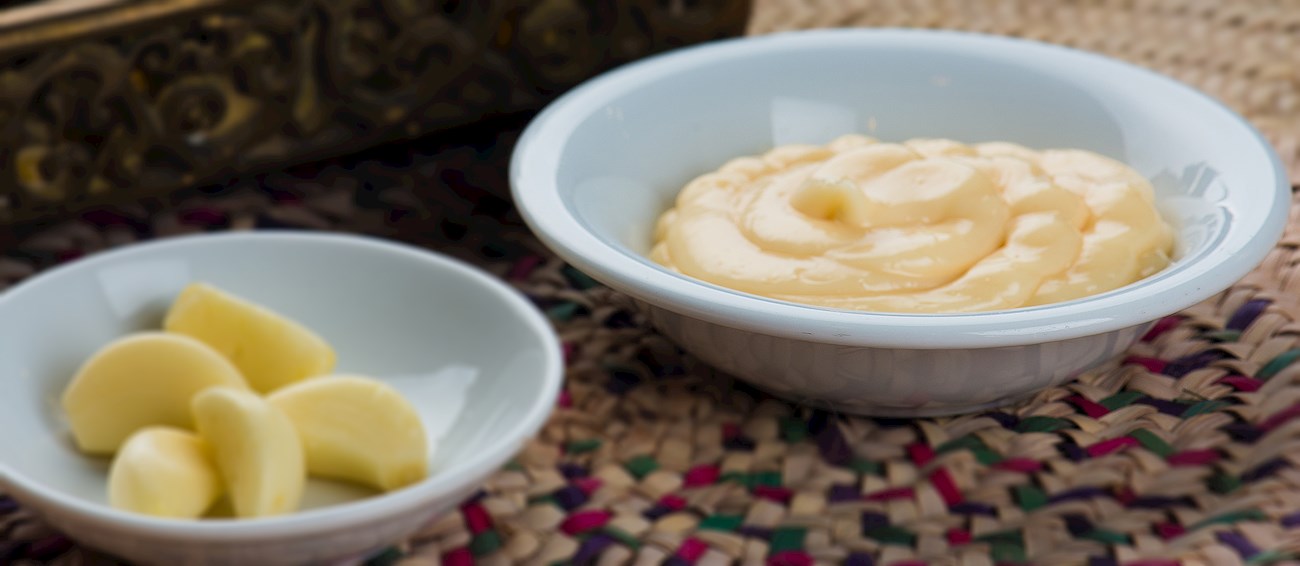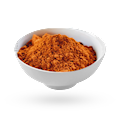MAIN INGREDIENTS
Awaze is a traditional sauce or spice paste that's served with most main dishes in the country. It's usually made with ingredients such as berbere spice blend, t'ej (Ethiopian honey wine), and oil. The ingredients are simply mixed together until the desired consistency is reached, and the sauce is then consumed immediately or stored in the fridge.
It can be used as a sauce or a dip for meat, but it's also often added to stews such as wat or used as a sandwich spread. If desired, the sauce can be enriched with ginger and garlic – everyone makes their awaze in a different way and there are many versions of the sauce.
Serve with
MAIN INGREDIENTS
Toum is an authentic Lebanese and Syrian garlic paste. It is made with whole garlic cloves, which are slowly crushed using a mortar and pestle, or nowadays simply ground in a food processor. During this process, oil (preferably neutral oil such as canola, or the flavorful olive oil) is gently added to create a homogeneous garlic paste with an unusual, fluffy texture.
Finally, salt and lemon juice are added to the mix, giving the paste a salty flavor and ivory color. Toum is used for marinades, sauces, and dips, and can enrich any meal. It is usually combined with chicken in traditional dishes such as roast chicken, chicken skewers or chicken shawarma, but is also commonly combined with beef, lamb, or goat meat.
Serve with
MAIN INGREDIENTS
Aji criollo or salsa de aji is a spicy Peruvian salsa prepared with a combination of yellow aji chili peppers and oil. The sauce is usually pleasantly spicy, but it can also be extremely hot and spicy, so one should be careful when tasting it for the first time.
The sauce is traditionally used as an accompaniment to various meat and fish dishes, but it's also often used as a dip for french fries and tequeños. Although it shares the name with an Ecuadorian sauce, those two differ significantly, both in appearance (Ecuadorian version is green), and in the method of preparation and ingredients used.
MAIN INGREDIENTS
Salsa ocopa is a popular Peruvian sauce originating from Arequipa. It is made with queso fresco, aji amarillo chilis, milk, and huacatay, also known as Peruvian black mint, giving the sauce a unique flavor. The salsa is traditionally served with boiled potatoes, but it can also accompany pasta dishes, meat, fried yucca, hard-boiled eggs, or tequeños.
Serve with
MAIN INGREDIENTS
Guasacaca is Venezuela's version of guacamole, although it is not as thick. This simple combination of avocado, coriander, parsley, bell peppers, onions, garlic, salt, oil, and vinegar is typically consumed with barbecued meats such as beef, chicken, sausages, and morcillas.
It is used as a dip with fried plantain and yuca, but it can also be drizzled on empanadas. The sauce is usually made in a blender, resulting in a creamy sauce, while some prefer the mashed version, resulting in a chunkier sauce.
Ragù all'anatra is an Italian meat sauce that's usually prepared with a combination of duck, garlic, onions, carrots, celery, guanciale, tomato purée, red wine, and herbs such as sage, parsley, bay leaves, and thyme. The vegetables are chopped and sautéed with the guanciale over high heat, followed by the duck, herbs, red wine, and tomato purée.
The combination is left to simmer until the duck becomes fully cooked. The duck is then removed, the meat chopped and placed back into the pot, and the sauce is later filtered to remove large quantities of duck fat. Once done, this hearty duck sauce is typically served with pasta such as pappardelle or tagliatelle.
Pesto Genovese is a sauce with origins in the Italian city of Genoa. Traditionally, it consists of basil, garlic, pine nuts, olive oil, and cheeses such as Parmigiano Reggiano or Pecorino. Its name stems from the word pestare, meaning to pound or crush, referring to the original method of making the sauce with a mortar and pestle.
It is said that pesto originated from the ancient Romans who ate a paste called moretum, made by crushing together ingredients such as cheese, herbs, and garlic. Pesto is usually used with pasta, traditionally with trofie or trenette, but can also sometimes be served with sliced tomatoes or boiled potatoes.
Serve with
MAIN INGREDIENTS
Ragù alla Bolognese was invented in the late 18th century by Alberto Alvisi, a chef of Pope Pius VII. The base of this classic is made with beef, pork or a combination of both, as well as ripe, fresh tomatoes or tomato purée, red or very dry white wine, nutmeg, salt, and pepper.
Common additions may also include Italian pancetta and milk or cream. Traditionally, ragù alla Bolognese is served with tagliatelle pasta, and it is an essential part of lasagne alla Bolognese. It can also pair well with pappardelle, fettuccine or homemade farfalle.
Named after Amatrice, a provincial town in the Sabine Hills northeast of Rome; the iconic Amatriciana sauce is often considered a part of the "holy trinity of Roman pasta", together with carbonara and cacio e pepe. Amatriciana was invented in the 17th century by adding tomatoes to the already famous gricia sauce – diced tomatoes are sautéed in fat rendered from juicy bits of guanciale (cured pork jowl), then tossed together with grated pecorino cheese and either spaghetti or bucatini pasta.
The first recipe for Amatriciana was published in the 1790 cookbook L’Apicio Moderno by Francesco Leonardi, a renowned Roman chef and author. Over time, this classic Italian dish became so popular it was featured in several movies, from Alberto Sordi’s 1954 film An American in Rome and Luciano Salce’s 1978 Where Are You Going on Holiday? to Ryan Murphy’s Eat Pray Love, in which Julia Roberts joyfully wolfs down a portion of spaghetti all’Amatriciana while sitting on the terrace of a typical Roman osteria.
MOST ICONIC Amatriciana
View moreMAIN INGREDIENTS
Mala is a brothy, spicy sauce consisting of Sichuan peppercorns, chili peppers, oil, and a handful of various spices. In Chinese gastronomy, it is considered as one of the most popular sauces with many regional varieties. The sauce is so spicy that it is even implicated in its name, the term málà literally meaning numbing and spicy, caused by the Sichuan peppercorns.
Although the origins of the sauce are still unclear, the most popular theory suggests that it was invented in Sichuan in the 19th and 20th century, when it was full of pier workers who were regularly eating cheap foods such as beef stomach, kidney, and solidified blood.
Serve with
TasteAtlas food rankings are based on the ratings of the TasteAtlas audience, with a series of mechanisms that recognize real users and that ignore bot, nationalist or local patriotic ratings, and give additional value to the ratings of users that the system recognizes as knowledgeable. For the “Top 100 Sauces in the World” list until February 13, 2025, 14,167 ratings were recorded, of which 8,898 were recognized by the system as legitimate. TasteAtlas Rankings should not be seen as the final global conclusion about food. Their purpose is to promote excellent local foods, instill pride in traditional dishes, and arouse curiosity about dishes you haven’t tried.





























































































































